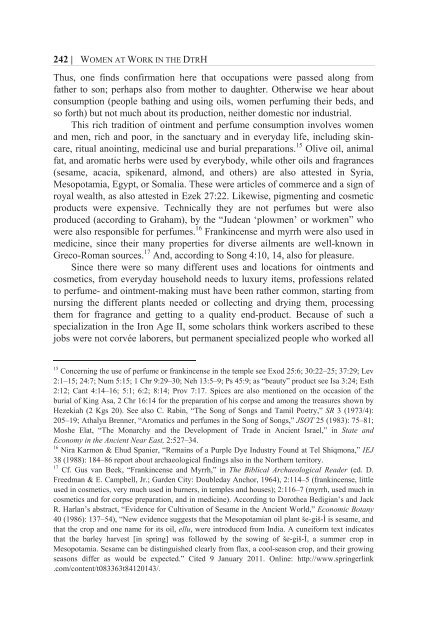Women at Work in the Deuteronomistic History - International Voices ...
Women at Work in the Deuteronomistic History - International Voices ...
Women at Work in the Deuteronomistic History - International Voices ...
Create successful ePaper yourself
Turn your PDF publications into a flip-book with our unique Google optimized e-Paper software.
242 | WOMEN AT WORK IN THE DTRH<br />
Thus, one f<strong>in</strong>ds confirm<strong>at</strong>ion here th<strong>at</strong> occup<strong>at</strong>ions were passed along from<br />
f<strong>at</strong>her to son; perhaps also from mo<strong>the</strong>r to daughter. O<strong>the</strong>rwise we hear about<br />
consumption (people b<strong>at</strong>h<strong>in</strong>g and us<strong>in</strong>g oils, women perfum<strong>in</strong>g <strong>the</strong>ir beds, and<br />
so forth) but not much about its production, nei<strong>the</strong>r domestic nor <strong>in</strong>dustrial.<br />
This rich tradition of o<strong>in</strong>tment and perfume consumption <strong>in</strong>volves women<br />
and men, rich and poor, <strong>in</strong> <strong>the</strong> sanctuary and <strong>in</strong> everyday life, <strong>in</strong>clud<strong>in</strong>g sk<strong>in</strong>care,<br />
ritual ano<strong>in</strong>t<strong>in</strong>g, medic<strong>in</strong>al use and burial prepar<strong>at</strong>ions. 15 Olive oil, animal<br />
f<strong>at</strong>, and arom<strong>at</strong>ic herbs were used by everybody, while o<strong>the</strong>r oils and fragrances<br />
(sesame, acacia, spikenard, almond, and o<strong>the</strong>rs) are also <strong>at</strong>tested <strong>in</strong> Syria,<br />
Mesopotamia, Egypt, or Somalia. These were articles of commerce and a sign of<br />
royal wealth, as also <strong>at</strong>tested <strong>in</strong> Ezek 27:22. Likewise, pigment<strong>in</strong>g and cosmetic<br />
products were expensive. Technically <strong>the</strong>y are not perfumes but were also<br />
produced (accord<strong>in</strong>g to Graham), by <strong>the</strong> “Judean ‘plowmen’ or workmen” who<br />
were also responsible for perfumes. 16 Frank<strong>in</strong>cense and myrrh were also used <strong>in</strong><br />
medic<strong>in</strong>e, s<strong>in</strong>ce <strong>the</strong>ir many properties for diverse ailments are well-known <strong>in</strong><br />
Greco-Roman sources. 17 And, accord<strong>in</strong>g to Song 4:10, 14, also for pleasure.<br />
S<strong>in</strong>ce <strong>the</strong>re were so many different uses and loc<strong>at</strong>ions for o<strong>in</strong>tments and<br />
cosmetics, from everyday household needs to luxury items, professions rel<strong>at</strong>ed<br />
to perfume- and o<strong>in</strong>tment-mak<strong>in</strong>g must have been r<strong>at</strong>her common, start<strong>in</strong>g from<br />
nurs<strong>in</strong>g <strong>the</strong> different plants needed or collect<strong>in</strong>g and dry<strong>in</strong>g <strong>the</strong>m, process<strong>in</strong>g<br />
<strong>the</strong>m for fragrance and gett<strong>in</strong>g to a quality end-product. Because of such a<br />
specializ<strong>at</strong>ion <strong>in</strong> <strong>the</strong> Iron Age II, some scholars th<strong>in</strong>k workers ascribed to <strong>the</strong>se<br />
jobs were not corvée laborers, but permanent specialized people who worked all<br />
15 Concern<strong>in</strong>g <strong>the</strong> use of perfume or frank<strong>in</strong>cense <strong>in</strong> <strong>the</strong> temple see Exod 25:6; 30:22–25; 37:29; Lev<br />
2:1–15; 24:7; Num 5:15; 1 Chr 9:29–30; Neh 13:5–9; Ps 45:9; as “beauty” product see Isa 3:24; Esth<br />
2:12; Cant 4:14–16; 5:1; 6:2; 8:14; Prov 7:17. Spices are also mentioned on <strong>the</strong> occasion of <strong>the</strong><br />
burial of K<strong>in</strong>g Asa, 2 Chr 16:14 for <strong>the</strong> prepar<strong>at</strong>ion of his corpse and among <strong>the</strong> treasures shown by<br />
Hezekiah (2 Kgs 20). See also C. Rab<strong>in</strong>, “The Song of Songs and Tamil Poetry,” SR 3 (1973/4):<br />
205–19; Athalya Brenner, “Arom<strong>at</strong>ics and perfumes <strong>in</strong> <strong>the</strong> Song of Songs,” JSOT 25 (1983): 75–81;<br />
Moshe El<strong>at</strong>, “The Monarchy and <strong>the</strong> Development of Trade <strong>in</strong> Ancient Israel,” <strong>in</strong> St<strong>at</strong>e and<br />
Economy <strong>in</strong> <strong>the</strong> Ancient Near East, 2:527–34.<br />
16 Nira Karmon & Ehud Spanier, “Rema<strong>in</strong>s of a Purple Dye Industry Found <strong>at</strong> Tel Shiqmona,” IEJ<br />
38 (1988): 184–86 report about archaeological f<strong>in</strong>d<strong>in</strong>gs also <strong>in</strong> <strong>the</strong> Nor<strong>the</strong>rn territory.<br />
17 Cf. Gus van Beek, “Frank<strong>in</strong>cense and Myrrh,” <strong>in</strong> The Biblical Archaeological Reader (ed. D.<br />
Freedman & E. Campbell, Jr.; Garden City: Doubleday Anchor, 1964), 2:114–5 (frank<strong>in</strong>cense, little<br />
used <strong>in</strong> cosmetics, very much used <strong>in</strong> burners, <strong>in</strong> temples and houses); 2:116–7 (myrrh, used much <strong>in</strong><br />
cosmetics and for corpse prepar<strong>at</strong>ion, and <strong>in</strong> medic<strong>in</strong>e). Accord<strong>in</strong>g to Doro<strong>the</strong>a Bedigian’s and Jack<br />
R. Harlan’s abstract, “Evidence for Cultiv<strong>at</strong>ion of Sesame <strong>in</strong> <strong>the</strong> Ancient World,” Economic Botany<br />
40 (1986): 137–54), “New evidence suggests th<strong>at</strong> <strong>the</strong> Mesopotamian oil plant še-giš-Ì is sesame, and<br />
th<strong>at</strong> <strong>the</strong> crop and one name for its oil, ellu, were <strong>in</strong>troduced from India. A cuneiform text <strong>in</strong>dic<strong>at</strong>es<br />
th<strong>at</strong> <strong>the</strong> barley harvest [<strong>in</strong> spr<strong>in</strong>g] was followed by <strong>the</strong> sow<strong>in</strong>g of še-giš-Ì, a summer crop <strong>in</strong><br />
Mesopotamia. Sesame can be dist<strong>in</strong>guished clearly from flax, a cool-season crop, and <strong>the</strong>ir grow<strong>in</strong>g<br />
seasons differ as would be expected.” Cited 9 January 2011. Onl<strong>in</strong>e: http://www.spr<strong>in</strong>gerl<strong>in</strong>k<br />
.com/content/t083363t84120143/.




